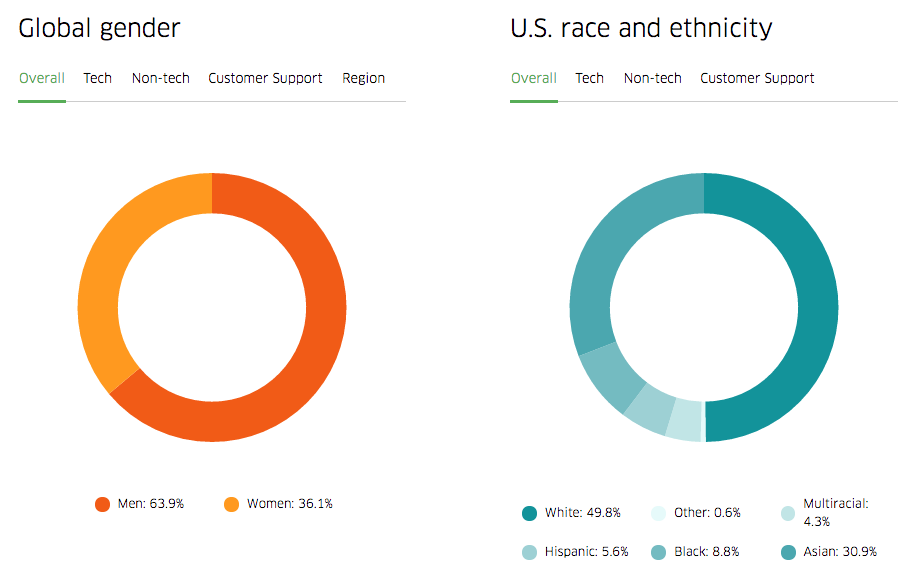Uber just released its highly anticipated, first-ever diversity report detailing the demographics of its employees as of this month. The TL;DR is that Uber, like many other tech companies, is predominantly white and male. What surprised me, though, is that Uber fares slightly better than Facebook and Apple when it comes to female representation. Uber also has pretty solid representation of people of color, in comparison to other tech companies.
“It’s no secret that we’re late to release these numbers,” Uber Chief Human Resources Officer Liane Hornsey wrote on Uber’s blog today. “And I’d like to thank our employees for their tenacity in arguing the case for greater transparency — because what you don’t measure, you can’t improve.”
Worldwide, Uber is 36.1 percent female and 63.9 percent male. In tech roles, women make up just 15.4 percent of the employee base.
Uber’s overall female representation is not great, but it’s not as bad as female representation at Facebook (32 percent female) and Apple (32 percent female), for example. It’s also not as good as female representation at Airbnb, which is 43 percent female, and Pinterest, which is 44 percent female.
Now about race. Yes, Uber is a predominantly white company (49.8 percent). That’s unfortunately the norm at U.S.-based tech companies, but where Uber shines is in its representation of black and Latinx people.
Overall, Uber is 8.8 percent black, 5.6 percent Latinx and 4.3 percent two more or races in the U.S. In technical roles, however, those percentages drop to 1 percent, 2.1 percent and 2.4 percent, respectively.

Here’s how Uber compares to others: Facebook (2 percent black, 4 percent Latinx, 3 percent two or more races), Apple (9 percent black, 12 percent Latinx, 2 percent multiracial), Airbnb (2.9 percent black, 6.5 percent Latinx) and Pinterest (2 percent black, 4 percent Latinx, 4 percent two or more races).
At the leadership level, 22 percent of Uber’s employees are women, 2.3 percent are black, 0.8 percent are Latinx and 76.7 percent are white. Surprise! Uber’s leadership team is mostly a bunch of white men.
In light of President Trump’s attack on immigrants, Uber also disclosed that 15 percent of its employees in the U.S. have a work visa and come from 71 different countries, saying that no matter where anyone comes from, Uber wants you to know that you have a place at the company. Uber also said it will continue to speak out against discrimination.
“This report is a first step in showing that diversity and inclusion is a priority at Uber,” Uber CEO Travis Kalanick said in a statement. “I know that we have been too slow in publishing our numbers — and that the best way to demonstrate our commitment to change is through transparency. And to make progress, it’s important we measure what matters.”
It’s worth noting that Uber doesn’t currently have specific goals in place. Physical representation of diverse employees is also just one part of the equation. Fostering an inclusive, non-hostile work environment where people don’t get sexually harassed is very important.
“While there are many things we need to change about our culture, I believe that making Uber a more diverse and inclusive workplace is key,” Hornsey wrote.
Uber also has committed $3 million over the next three years to support organizations focused on underrepresented minorities and women in tech. Uber has yet to decide which organizations to support, but Hornsey says “employees will be crucial” in that decision-making process.
All of this comes following allegations of sexual harassment from former Uber engineer Susan Fowler Rigetti. Since then, Uber has initiated an internal investigation about the claims and has expressed its commitment to diversity. That all happened in February, about a month after Rev. Jesse Jackson called on Uber to release its data.
“As we enter the new year, some 2 ½ years since the floodgates opened, we urge Uber to ‘lean in’ and join the ranks of technology companies that are reporting your diversity and inclusion data,” Jackson wrote in a letter to Kalanick in January, which TechCrunch obtained.
Specifically, Jackson called for Uber to publicly disclose its EEO-1 report, disclose the number of new hires made between 2014-2016 and what percentage of them were people of color and report the demographics of its board of directors and C-suite leadership team. Jackson asked to receive this information by February 15, 2017.
Clearly, that didn’t happen. It wasn’t until just about everyone turned against Uber in light of allegations of sexual harassment that the company decided to finally do it.
Both Hornsey and Kalanick have noted that Uber has been slow, in comparison to other tech companies, to release its diversity numbers. But, believe it or not, Uber was not the only high-profile tech company holding out. Both Lyft and Snap, for example, have been very quiet on the diversity front.
Moving forward, Hornsey says Uber will work with outside diversity and inclusion experts “who have been working on these issues for longer than we’ve been around — and who are working to make change happen.”
You can learn more about Uber’s diversity and inclusion initiative on its new site here.
